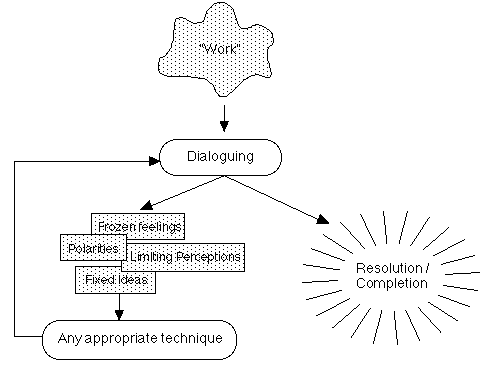
At first glance, dialoguing looks like just a casual conversation. For that matter, the client might not realize that there is any particular technique being used. But dialoguing is a very focused activity. It is focused towards getting a more and more clear picture of what is there within certain parameters. We are trying to get a handle on what is there to get a handle on. What exactly that is, we don't know when we start.
We start out with a more or less vague subject, or maybe just with the inkling that there is something there that ought to be worked on. It might simply be that the client came to see you, and now she is sitting in the chair in front of you and neither you nor she knows exactly what it would be best to work on. Dialoguing is what you do to find out. Maybe the client gives a general subject of concern, like "Work", but we don't know exactly what it is about "work" that ought to be changed. We enter into a dialogue to find out what we are really talking about.
We start with a foggy situation. Either we don't know at all what it is, or we don't know enough to know what to do with it. There is a generality there. We are going to dig up some specifics about it.
We are not counting on that it is ONE specific thing that is there. It is rather that we will find out more and more about whatever it is. It might be a complex situation with many details to it. We will find out one detail at a time.
Several things might come out of that:
1) The situation might resolve. We might have found out enough so that there no longer is a problem or anything that needs to be done. Or it might now be clear to the client what she should do, and she just needs to go and take action out in life. In either case it is the completion of dialoguing as a process.
2) We might hit on a specific phenomenon within the general area that calls for one of the more specialized techniques we know. We might hit upon an unwanted body feeling, a polarity, or something else we have a direct, effective technique for. We aren't going to take just anything. But if we find a recognizable structure that obviously is key to the subject at hand, we need to deal with it. When we finish the technique we picked, we will go back and see how the overall subject is doing and continue the dialogue, if necessary, to get deeper into it.

If we don't have a subject at session start, there is the special case of using dialoguing to get a subject. That is still a focused process, it is focused on the outcome of getting something to work on. In that case, we wouldn't be branching off to any other technique before we have established a subject to work on.
In dialoguing, the facilitator will use questions that will help the client to learn more about the subject and see what it really is. Facilitator and client are working together to find out what it is. It is not just a method of getting the client to talk, the facilitator must be actively interested in finding out too.
There are different methods of questioning that the facilitator can use:
Promoting talking: Asking for thoughts, considerations, feelings, etc. on the subject.
Promoting looking: "How does it seem to you now?", "What is it?", getting specifics.
Loosening up: Using Unblocking or Unburdening keys.
Challenging illogic: Fishing for fixed ideas: "Why is that?", "What is behind that?"
Asking for specifics when they are missing, vague, or general.
Questioning anything that is "impossible", or that one "has to do"
Questioning beliefs: "Who says that?", "How do you know that?"
Echoing: Giving back one's understanding and asking if that is what is meant.
It is important not to demonstrate indecisiveness by getting off the subject and not to judge anything that comes up. The skill in dialoguing is in coaxing the client into looking in the right places without violating the facilitator code.
Any one of the questioning methods can be done in a distracting, invalidating, judging way that wouldn't work. What makes the difference is probably how well the facilitator is in rapport with the client. The facilitator shouldn't oppose or judge, but only assist looking and understanding.
What it is valuable to get the client to do, is to tell what is there, what she perceives, and so forth. She is introverted, telling about what is in her space. It is not useful when she is outside asking questions. If she is just wondering and telling you what she doesn't know, then we aren't really helping her.
Maybes just aren't what is going to produce change. We need to keep the client looking and feeling what is there and talking about it. It might not be the ultimately true thing she is perceiving, that doesn't matter. What matters is that she keeps looking and communicating.